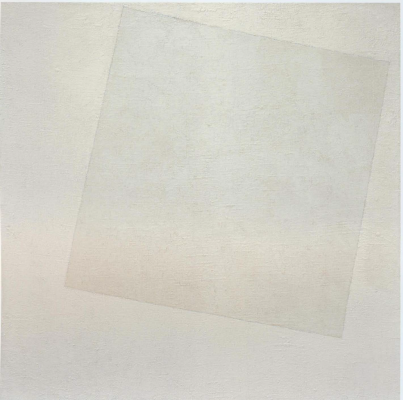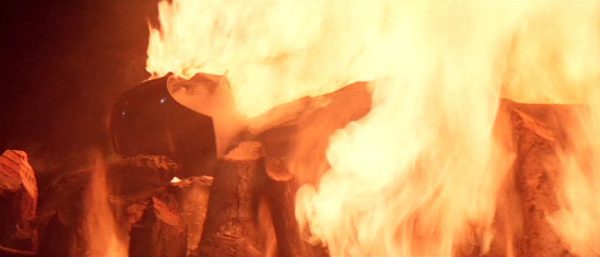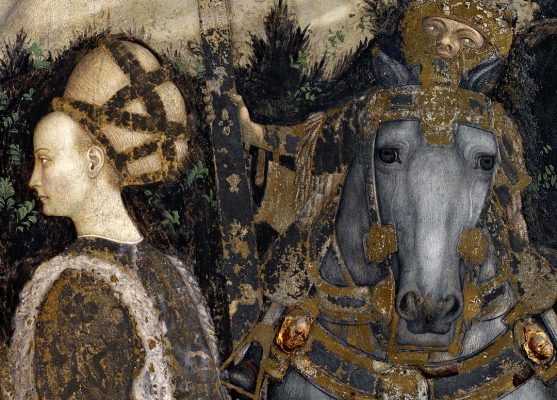Karl Ove Knausgaard’s My Struggle has an oddly medieval form: a cycle, composed of six auto-biographical books about the Norwegian author’s life. The project was born of abandon, as he has it: ‘I was looking for something and at the end I was so frustrated I thought I would just write it as it was, no tricks, no nothing… I just wanted to tell a story, which is the story of my life, basically [sic].’
There’s a shrug of false modesty here. Some way into the enterprise he must have envisioned a work of literary greatness taking shape; the hints lie in the colossal scale of the work, its dark and knowing title, the decision to call the volumes novels. Yet, on a structural and stylistic level, the fed-up beginnings and pared-down motives reflect the true character of the writing. In his magnum opus, Knausgaard has dispensed with most of the narrative conventions inscribed in realist fiction – no plot, no genre, no varnish. At first, the books read as exercises in self-scrutiny without aesthetic agenda, an uncut abundance of descriptive detail, where the absence of any clear hierarchy of interest makes for peculiarly flat prose.
A passage on smuggling out beer for a New Year’s Eve party when a teenager is as vividly evoked as falling in love as an adult. It’s a weird effect, disappointing for those who crave the relief of a fictive superstructure, but it gives the reader a sense of living at the level of first-hand experience, where the longing for a drink can be as strong to a boy as feelings for his wife are to a man. Life is, of course, flatter than fiction makes it, without recourse to the teleological depth of a plot or the broader understanding of an omniscient narrator. But it’s also closer to the written word than the more aloof products of postmodern experiment would lead you to believe. Knausgaard’s achievement is not so much to tell the truth about his life, but to write it in a way that reflects that honesty, a veracious style, if you will. And perhaps the strangest thing about it is that it works like the best fantasy – by creating a comprehensive parallel world of words.
At first, the books do not appear artful. The writing is myopic, raw, chaotic, wandering; the author prone to introspection and wont to veer, within the space of a few pages, from a documented walk through Stockholm into a state-of-the-nation rant about Sweden and thence to self-loathing diatribe on fancying strangers, culminating in lust-fuelled speculation on the habits of the pretty waitress in the coffee house he has reached. This is not new, finding meandering precedent in Herman Melville’s Moby Dick, Laurence Sterne’s Tristram Shandy and James Joyce’s Ulysses, but the difference is that Knausgaard doesn’t seem to share the radical aims of these historic authors. His writing is a desperate truth-telling putsch, its shaggy sprawl the stuff of dogged honesty rather than formal invention.
He hit upon this modus operandi by rejecting the contemporary trends in creative writing. Against a school of honed minimalism and refined intellectualization, or elaborate fictive construct, he opened up his prose and poured himself in. This has brought to his books a rare energy, as well as no small amount of infamy. One man set fire to the K section of a Malmö bookshop in a fit of anti-Knausgaard rage. Haters have pilloried the arrogance and tedium of his rambling, the self-obsession of his perspective. At its worst, it might be lousy craftsmanship masquerading as technique but at best a more animate and intimate way of composing literature – writing that seems closer to life as we live it.
This effect is not incidental and the books are more planned than they might first appear to be; they create a vivid sense of life by careful curation of so much wild expression and obsessive document. Though the writing adheres to no strict chronology, the emotional ups and downs in the text give it a rhythm, the sequencing of phases has an instinctive logic. The first book in the cycle follows the momentum of Knausgaard’s darkening relationship with his father. The second book performs the conflict between the loves of his life: literature and his family. The third book opens with his arrival on the island of Tromoya as a baby and closes with his departure from it as teenager. None of this is as arbitrary as the nonchalant and wayward delivery might suggest and the process of selection serves to create a more faithful, or representative portrait than a diary could – the reader sees the spread of incidents and interrelated elements that make up this life – without introducing the artifice of an all-seeing narrator.
Numerous literary traditions are also in evidence throughout the novels: epic, adventure quest, bildungsroman and Norse saga – the latter discernible in those places where the author makes a virtue of repetition, turning his everyday rituals and compulsive personality into something like ancient pattern. There are also individual literary influences at work: most obviously Fyodor Dostoevsky, whose presence is felt in the unbound energy of the writing, Knausgaard’s manifest obsession with self-destructive masculinity, his yearning for the sublime, occasional indulgence in swashbuckling Romanticism, recourse to guilt-racked confessional, Puritanical spirit, and, most specifically, the way in which he coordinates seemingly divergent philosophical reflections with the sweep of his own family drama. But Dostoevsky is a world away from the banality of nappies and tea-making, far from the frustrations a contemporary man might feel in feminist culture, a few elegant eras shy of Knausgaard’s brutal frankness. The more common comparisons between Knausgaard and Proust, though justified in light of the length and intensely personal nature of the My Struggle cycle, also miss the character and quality of these novels. They are not works of crystalline brilliance or clear, controlled method, starker than either of these literary forebears. Proust’s immaculate surfaces might hold so many polished mirrors up to life; and Dostoevsky offer gothic-rose, dirt-spotted windows on the world, but Knausgaard gives us the subjective jelly of an eye.
In the books, he talks about figurative painters more than he does about other authors, expressing an interest that perhaps informs the direct physicality of his prose and frees it from what Will Self decries as ‘the stranglehold of nineteenth century narrative’ on fiction. To me, Knausgaard’s closest artistic relatives are Northern European Renaissance painters, who built up a plethora of depicted detail to create a fully formed, but emphatically flat world-view. It is entirely different to the more celebrated illusionistic realism of Southern European Renaissance painting, and works by mapping perceived minutiae as a surface, rather than creating illusions of spatial depth through the application of perspective – in much the same way that Knausgaard’s stance is antithetical to the dominant trend of fictive realism in contemporary American literature, as he painstakingly records and patterns his life, rather than inventing life-like characters and situations. The style of the old Nordic painting masters articulated certain paradoxes of art – arriving at truth through accepted artifice, creating a bigger picture by attending to the smaller details. In the hands of a contemporary writer, it becomes an incomparably powerful way of compressing a life in a book.
But for many, the straight-talking familiarity of his prose is the main pull of its appeal. Knausgaard has set out his life with such uncanny accuracy that he has acquired a cult of identification across Europe. Readers recognise parts of their own lives in the My Struggle novels: from A Death in the Family which animates the trials of adolescence in florid detail; to A Man in Love, which chronicles a young man’s relationships with his wife, friends and children. The latest installment to be published in English is the third volume, Boyhood Island, an infant odyssey through playground politics, scatological intrigue and the embarrassment and loneliness of growing up. Knausgaard has an unrivalled ability to depict ordinary incidents with bracing clarity and depth, and has brought a new force of truth to many clichés of experience. He tells commonly-shared stories in all their original oddity, offsetting them with anecdotes specific to himself and in this way reinvests clichés with meaning, a rare and significant achievement in and of itself.
To critics and critical readers, the casual originality of his process is of equal interest. The cycle has received rave reviews across Europe and in the British broadsheets, incurring hyperbolic praise from the likes of Rachel Cusk and Zadie Smith. And with good reason. The My Struggle cycle alters the parameters of literature in a way that calls to mind the moment in art history when the YBAs rendered all objects potentially art-worthy. Which is not to say it is like Tracey Emin’s bed; a crucial difference being that, unlike so much nineties gallery furniture, Knausgaard’s books are not primarily about art, and especially not about their own status as art (though this is not off topic either). It is precisely the creative self-involvement of postmodernism that Knausgaard is trying to escape, as he makes clear in A Death in the Family:
Art has become an unmade bed, a couple of photocopiers in a room, a motorbike in an attic. And art has come to be a spectator of itself. Art does not know a beyond… Those in this situation who call for more intellectual depth, more spirituality, have understood nothing, for the problem is that the intellect has taken over everything. The limits of that which cannot speak to us – the unfathomable – no longer exist. We understand everything, and we do so because we have turned everything into ourselves.
There is a degree of hypocrisy here. Knausgaard is after all writing about writing, and the function of art. Some smart savants will also point out a certain philosopher he has neglected to read who proves that, for us humans, there is indeed nothing outside of our heads. But of course there is, he argues; the fact that we may not be able to access it as thinking beings only makes it more compelling as a ‘beyond’. What makes his position here both refreshing and old-fashioned is that he still seeks a ‘beyond’ at all, and furthermore, one that precludes language and intellect, configuring literature as a secondary phenomena, to be shaped by the primary pressures of life.
In some ways, it’s a more hopeful premise than the de-humanised emphasis on formal pyrotechnics pioneered by the literary likes of Thomas Pynchon and feted since the seventies. Concerted experimentation has no relevance for Knausgaard, since any novelty in the writing arises out of the approach to the subject (life), or the unpredictable nature of the subject (life) itself, rather than crafty handling. This is boldly anachronistic in a culture that seeks more answers, meaning and beauty than the world, clearly perceived, starkly questioned and honestly presented, might readily offer. It’s a gesture of faith in the value of life and in literature, but it risks meaninglessness, as well as that gravest of creative crimes: being boring.
Though the prose is occasionally pinched by philosophical epiphanies, for the most part Knausgaard’s written life gutters on with climaxes of unmediated feeling that create an unredeemed sense of being in the world. Among the most memorable passages in the books are its most intensely physical descriptions. For instance, in Boyhood Island, where he recalls his tortuous first kiss: ‘The root of my tongue ached. More saliva from the corners of our mouths. My dental brace occasionally knocked against her teeth’. More disturbing is the final third of A Death in the Family where he documents the aftermath of his father’s suicide as a series of overwhelming sensory experiences, rather than a time of psychological difficulty.
His father dies having drunk himself incapable over several years in his aging mother’s house and leaves a mess of horrifying proportions that Knausgaard and his brother Yngve have to clear up. The job is described in shockingly concrete terms, as in the following extract:
In the middle of the floor was a pile of clothes as tall as I was, it almost reached the ceiling. That was where the rotting smell must have come from. I switched on the light. Towels, sheets, table cloths, trousers, jumpers, dresses, underwear, they had chucked it all in here. The lowest layers were not only mildewed, they were decomposing. I squatted down and prodded with my finger. It was soft and sticky.
The irreverent finger comes directly at the reader here, inserting us into his experience and reducing it to basic form and texture. The viscerally gross nature of the situation looms larger than any emotion at this stage, as it presumably did for Knausgaard during the period evoked. This is often the case in supposedly traumatic episodes: the world precedes the embellishments of thought. Knausgaard captures something of such immediacy in a way that perhaps only writing can. These could only be novels, never poetry, nor paintings for they consist of passages that even the most modest meter, faintest colour might make more beautiful than true. Whereas words, in Knausgaard’s writing, can seem artlessly direct.
There are also recollections of surprising loveliness in the books, the more affecting for their verbal adroitness. A personal favourite is the bit about his brother’s smell in Boyhood Island:
‘There you go,’ Yngve said, releasing some almonds into my palm. I could clearly recognise his odour. It was acrid yet faint, almost metallic. Not his sweat, that smelt different, but his skin. It smelled of metal. When we wrestled I could smell it, when he tickled me I could smell it, and sometimes when he was lying down and reading, for example, I could put my nose to his arm and breath in the smell. I loved him, I loved Yngve.
These must be among the most beautiful lines written on the kind of feeling young siblings can have for one another, and typically for Knausgaard, that feeling derives from the physical elements of the relationship. ‘Physical’ is to some extent, a dirty word in literature, but Knausgaard makes it something seldom sexual and often full of its own impregnable meaning.
This is a child’s skill and it is not a coincidence that he has arrived at this material way of writing, if you can call it that, via memories of his own childhood. At the start of Boyhood Island, he maintains that ‘landscape in childhood is not like the landscape that follows later; they are charged in very different ways. In that [former] landscape every rock, every tree had a meaning’. It is a point he makes repeatedly through the books, as at the end of A Death in the Family where he writes:
The sole difference, which is the difference between a child’s reality and adult’s, was that they were no longer laden with meaning. A pair of Le Coq football boots was just a pair of football boots. If I felt anything when I held a pair in my hands now it was only a hangover from my childhood, nothing else, nothing in itself.
Some hangover, or a despairing note in a composition that often succeeds in restoring some of that meaning to his adult life. One of the most distinctive qualities in these novels is the way in which the writing combines the infant and adult versions of Karl Ove, the grasp each has on his surroundings. The cycle is, of course, the work of a seriously skilled, middle-aged man of letters, but it has much of the guileless honesty and literal sensitivity of a boy. Together they offer a fuller sense of identity, not only Knausgaard’s own, but that of every adult with a past, whose view of the present is informed by a host of former selves.
And if Knausgaard doesn’t ever retrieve his younger self’s instinctive ability to find sense in the world, he does at least seek out grown-up equivalents. A sadness the books acknowledge, in the tradition of J M Barrie, Lewis Carroll and company, is how much harder this becomes with age. The process is more haphazard and laborious, no longer spontaneous – an act of art rather than impulse of imagination. It is a process on which Knausgaard, as a father, often muses; here, aptly, on a playground:
The bell had rung. The sounds here were new and unfamiliar to me, the same was true of the rhythm in which they surfaced, but I would soon get used to the rhythm of them, to such an extent that they would fade into the background again. You know too little and it doesn’t exist. You know too much and it doesn’t exist. Writing is drawing the essence of what we know out of the shadows. That is what writing is about. Not what happens there, not what actions are played out there, but the there itself. There, that is writing’s location and aim. But how to get there?
This last question is the pivot of the whole project. It is one that the books answer by example rather than fact. As it turns out, ‘there’ is often right under his nose.
In Boyhood Island Knausgaard recalls a story that had a strong hold on him as a child. It is about a boy gifted with wizard powers. The story goes that: ‘All objects and all creatures had a name corresponding to their essence, and only by knowing the objects’ and creatures’ real name could they be controlled. Ged could do that.’ But Ged abuses his powers and opens a door to the kingdom of death, from where a shadow escapes and follows him round the world. In the end he has to face the terrifying shade and the punchline of the story is that, in the confrontation, he discovers the shadow to be himself. Since this is Knausgaard, we can trust this to be the remembered story he says it is, rather than a conceit, but it offers a fitting analogy for the focus of his fiction. The wizard power is much like the literary ability to find the words with which to draw ‘the essence of what we know out of the shadows’, as he puts it in the first book. Here, the shadow is the spectre of self in one’s own writing. The moral of the story is perhaps that the darkest mysteries are often the nearest; a visionary might merely be someone who can see himself aright.
There is a connection between this story and one by the late Chilean author Roberto Bolaño, a writer Knausgaard has acknowledged as an influence. The story is called ‘Dentist’ and follows two characters knocking about town, drinking and arguing about art:
Then he launched into an argument whose principal objective was to discredit art… When I tried to point out that what had happened between him and Cavernas was an incident in his life story, not an episode in art history, so that it might be used to discredit certain persons, but not artists in general and certainly not art itself, my friend hit the roof.
But that’s where art comes from, he said: life stories. Art history comes along only much later.That’s what art is, he said, the story of a life in all its particularity. It’s the only thing that really is particular and personal. It’s the expression of and, at the same time, the fabric of the particular. And what do you mean by the fabric of the particular, I asked, supposing he would answer: Art…. But my friend said: What I mean is the secret story… So now you’re wondering what I mean by the secret story? Asked my friend. Well, the secret story is the one we’ll never know, although we’re living it from day to day, thinking we’re alive, thinking we’ve got it all under control and the stuff we overlook doesn’t matter. But every single damn thing matters! Only we don’t realise. We just tell ourselves that art runs on one track and life, our lives, on another, and we don’t realise that it’s a lie.
For Knausgaard and Bolaño the ‘secret’ is the obvious truth passed over, the shallow insight. There are many shades of darkness in Knausgaard’s books: black-outs of shame, moments of obscure mysticism and the omnipresence of death in his thinking. But there is also an everyday darkness in those easily-missed elements that form the greater part of his life: the weather, people, objects, natural phenomena, and much that might seem mundane beyond mention, though it informs everything.
Knausgaard’s writing is an attempt to recreate a life in all its indiscriminate detail; it is ‘the expression of, and at the same time, the fabric of the particular’. This comes about through an excoriating effort of description, but also intuition and belief, through feeling out those areas of omission that underwrite all known fact, thought and emotion. Part of this process is giving the lie to the edited face of literature, illuminating the way it tidies life’s grey areas into chiaroscuro. But Knausgaard wants both nature and the novel: the uncomprehended hinterland of experience and its shapely literary afterlife. Meaning lies in the encounter between the two, which he coordinates in a present historic narrative that is as muddled and bleak as it is consolingly accurate and desperately beautiful. It is a great act of flattening, the creation of a literary plane on which everything – lofty musing, crude observation, social commentary, private thought, the seen world and its shadow – is of a richly ragged piece.




